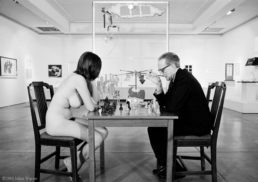David Gamble: Andy Warhol's House
admin
OCTOBER 14, 2019 | DAVID GAMBLE
In 1988 Sotheby’s New York hosted one of the most talked-about auctions of the decade, the sale of the Estate of Andy Warhol. In addition to paintings and sculpture, some of the most hotly sought-after items were Warhol’s personal effects. The goal of the sale was to raise funds for the then fledgling Andy Warhol Foundation for the Visual Arts.
Soon after Warhol’s death in 1987, photographer David Gamble was given exclusive access to Warhol’s East 66th street House, Factory and Warehouse. There, he captured the placement of Warhol’s belongings as the artist had lived with them over the years. Rather than simply documenting the space, and Warhol’s objects. Gamble’s images sought to capture the humanity and fierce individuality of the artist.
Please join us for an intimate look into the life of this beloved Pop icon as the Art Institute of Chicago launches its major retrospective ANDY WARHOL — FROM A TO B AND BACK AGAIN that “illuminates the breadth, depth and interconnectedness of Warhol’s production across the entirety of his career but also ways he anticipated the issues, effects, and pace of our current digital age.”
Legendary photojournalist Julian Wasser reflects on career, discusses Chicago exhibit
admin
CHICAGO (WLS) — Julian Wasser has witnessed Hollywood through a camera lens for well over half a century, capturing images of stars from Jack Nicholson to The Beatles, and he even got one of the very last pictures of Robert Kennedy before his assassination.
The view can be seen in a special exhibit, “Julian Wasser: The Way We Were,” a photographic time capsule of the 1960’s and 1970’s.
ABC7 Chicago’s Janet Davies talked to him about his new exhibit that opened Friday in River North.
Wasser began shooting spot news in the nation’s capital at a tender age.
Julian Wasser: “Every night I would climb out my bedroom window and steal my father’s car when I was 12 and take pictures, and they’d be on the front page of the Washington Post. My father would say ‘look, there’s another Julian Wasser in Washington.’ I said ‘yeah dad.'”
Later Wasser’s camera took him to New York then Los Angeles, shooting stars for publications like Time Magazine, Vanity Fair and Life Magazine.
Wasser: “Most photographers would get a star, line them up against a wall and stand there and don’t say anything. They would wait for the star to do something, I can’t stand that. They want direction. I gave lots of directions. They liked that and worked well with that. That’s why pictures look the way they do.”
Wasser’s career has spanned over six decades, and each of his iconic photographs has a story.
Wasser: “The Beatles, which was taken in London in Soho. Jayne Mansfield was at the Whiskey, I was shooting for Life Magazine. David Bowie, I was working for him, shooting at the Hollywood Bowl at one of his concerts.”
Janet Davies: “How about that Hugh Hefner photo on roller skates?”
Wasser: “He had incredible luck with women, didn’t he? He was actually a very, very nice guy, very sweet guy, he treated those girls like queens.
Davies: “What about the Marilyn one?”
Wasser: “I wanted to look at her, so I sat at her feet like a lap dog and took the pictures; she didn’t even know I was there, she’s a star!”
Wasser’s iconic photos are on display at the Hilton-Asmus Contemporary Gallery through September 30th.
“Julian Wasser: The Way We Were” runs through September 30th at the Hilton-Asmus Contemporary Gallery.
Wasser will be at the exhibit Friday from 6:45 p.m.- 9 p.m.
Hilton-Asmus Contemporary
716 N. Wells St., #3739, Chicago, IL 60654
www.hiltoncontemporary.com


